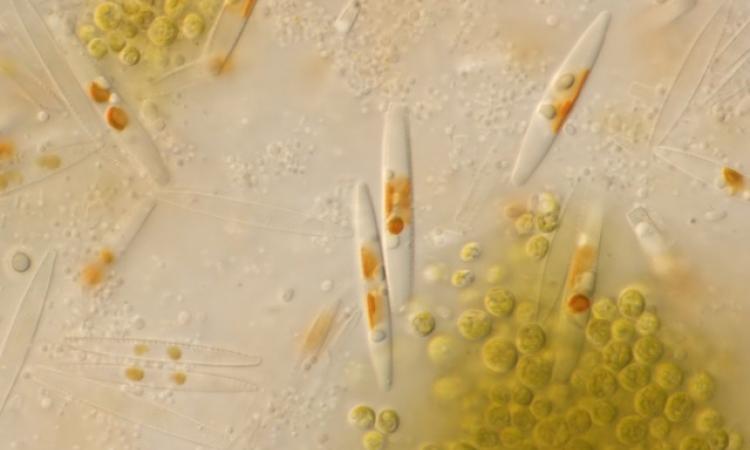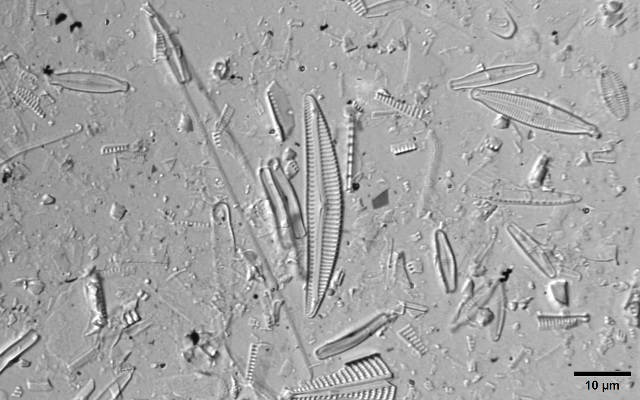
Dr. Karthick Balasubramanian, a freshwater biologist from Agharkar Research Institute, Pune shares very interesting facts about diatoms, unique organisms inhabiting freshwater ecosystems, in this webinar organised by Bangalore Life Science Cluster (BLiSC) and cohosted by Biologia Life Science.
Ever wondered what kind of life exists in rivers, lakes and ponds, even in a handful of water that you scoop up from these water bodies? This water in its natural form is full of wonders that lie submerged, invisible to the naked eye. A number of beautiful and unique organisms inhabit freshwater ecosystems, and play a very important role in maintaining the health of aquatic ecosystems.
Dr Karthick informs “One such interesting and ubiquitous group of organisms, often referred to as living glass houses and found abundantly in the water are - diatoms. Diatoms play a very important role in indicating the extent of pollution of water bodies such as rivers, lakes and ponds!”.
What are diatoms
He adds, “Diatoms are unicellular golden brown microscopic algae of various shapes that are abundant in nearly all habitats from freshwater to brackish water. They have a skeleton made up of silica and two valves that make them look like a soapbox or a baseball cut in the middle. While a number of micro algae are present in water, diatoms are unique because they are the only species having silica in their cells”
This silica cell wall protects the diatoms from light induced damage due to photosynthetic activity, helps the diatoms in their nutritional uptake, acts as a protective barrier against organisms that feed on the diatoms and maintains their buoyancy [1]. The silica content in a diatom varies according to species and depends on the size, growth pattern, and environmental variables such as light, temperature, salinity, nutrients, and growth phase [1].
Diatoms thus occur in varied shapes and sizes depending on their silica content and can be seen in the form of beautiful patterns when observed under the microscope. While there are more than 200,000 species of diatoms distributed in different ecosystems, only 50,000 species are known as of now. It is estimated that about 70 percent of the diatom species occur in freshwater, and 83 percent are benthic (found at the bottom of a water body attached to the rock, aquatic plants or sediments) [1].

Diatoms either live as a single cell or in colonies, reproduce rapidly, growing normally on wet surfaces and their size can range from less than 10 - 200 microns.
Dr Karthick adds, “Diatoms can survive in diverse environments, right from very hot boiling springs to extreme cold water and from freshwater to saltwater. They have specific environmental requirements, which means that specific species have exclusively adapted to particular environmental conditions and cannot survive or react when there is a change in the environment. The first noted diatoms were discovered in 1703. India’s first observed diatom was found in 1854”.
Why are diatoms so important?
Did you know that we owe every breath we take to diatoms?
Dr Karthick informs, “Diatoms are one of the important primary producers of oxygen on our planet and are known to produce as high as 25 percent of the global oxygen that we breathe through photosynthesis! Almost every fourth breath we take, we owe it to diatoms”.
During photosynthesis, diatoms use energy from light to convert water and carbon dioxide into sugars for food. By-products created from this process include organic carbon and oxygen. This process is called carbon fixation. Through carbon fixation, diatoms remove carbon dioxide (CO2) from the atmosphere.
According to estimates, diatoms facilitate up to 25 percent of all organic carbon fixation that occurs on the Earth, which is about equal to the carbon fixation done by all tropical forests combined! Researchers are now exploring the role of diatoms in reducing greenhouse gases [2].
Diatoms feed the oceans, lakes and rivers
Diatoms produce long-chain fatty acids and are an important source of these energy rich molecules that are a source of food for the entire food web, from zooplankton to aquatic insects to fish and whales [3].
Diatoms tell us about the health of aquatic ecosystems
“Diatoms can be greatly useful as bioindicators because of the property of specific species to remain restricted and survive only in in specific environments” adds Dr Karthick.
While aquatic ecosystems such as rivers, lakes support a wide variety of life, urbanisation and industrialisation have gradually taken a toll and have transformed these ecosystems into heavily polluted zones. Discharge of large amounts of untreated sewage, pesticides, fertilisers, pharmaceutical wastes, industrial effluents have led to dangerous levels of pollution of rivers and lakes in India. These pose a great threat to the aquatic ecosystems, to the organisms that live in these waters and to communities that depend on these systems for water and livelihoods.
Conventional methods for monitoring the pollution of water bodies assess the chemical load in the water and are useful as indirect measures of the health of the aquatic ecosystems. This is because they do not look directly at biological responses to pollution and only provide a snapshot of the ecosystem health, as chemical concentrations can vary from day to day depending on the time and can be affected by rainfall and water flow patterns [4].
Chemical sampling also does not look at the biological threats to ecosystem health, such as the presence of invasive species. In contrast, biological communities or species living in the water respond to minute changes in the chemical, physical and biological composition of water over the course of their lives. Monitoring these responses can directly help in detecting disturbances in the aquatic ecosystems. Biological monitoring is thus considered as a valuable indicator of the health of freshwater ecosystems [4].
Several organisms such as bacteria, protozoans, algae, zooplankton, fish etc have been used as bio indicators to monitor health of water bodies. However, use of diatoms is preferred as compared to other organisms because of a number of advantages they present. For example, they have extended survival rates and they multiply and grow very fast under favourable conditions as compared to microalgae, fish, and other micro invertebrates [1].
Diatoms can survive in a range of habitats such as oceans, lakes, estuaries, wetlands, etc. They are highly sensitive to metal pollution which helps in early identification of heavy metal pollution in aquatic ecosystems. They respond quickly to any organic or nutrient contamination. However, their potential continues to be underutilised as of now [1].
Diatoms have a role to play in biofuel production
Fossil fuels are diminishing and the demand for biofuel production has been increasing in recent years with diatoms being identified as the best candidate for biofuel production. Some strains of diatoms produce lipids as 50 percent to 80 percent of the dry weight that can be used in the production of biofuel making them an ideal substitute for fossil fuels [1].
Diatoms are greatly useful as nutritional supplements
Diatoms are emerging as leading nutraceutical ingredients (used to manufacture dietary supplements or vitamins) products from a biotechnological point of view since they are equipped with polyunsaturated fatty acids, essential amino acids, pigments, and vitamins [1].
Diatoms are useful in studying past climatic events
Diatoms can provide valuable insights into the past climatic events. Palaeoclimatology is the study of past climatic conditions that can help to predict future climatic conditions. Fossil remains of diatoms (the silica walls of the diatoms get preserved as fossils) are greatly helpful in developing an understanding of past events that occurred on the earth’s surface and about different conditions in the past including ocean acidification levels, sea surface temperatures, presence of ice cover, and the presence and extent of carbon dioxide and oxygen in the atmosphere [5].
“The applications and uses of diatoms are myriad and further research into diatoms continues to reveal exciting possibilities and applications in varied fields, informs Dr Karthick.
So next time you draw out water from a pond or a river, spare a thought for all the unique and interesting life forms that this drop of water might harbour!
The authors are thankful to Professor Soudhamini and Pavithra from Bangalore Life Science Cluster (BLISc) for organising and Biologia Life Science LLP for cohosting the series on freshwater ecosystems and for their support.
Dr Sameer Padhye is associated with Biologia Life Science LLP, Ahmednagar, Maharashtra, India.
The video of the talk by Dr Karthick Balsubramanian can be accessed here